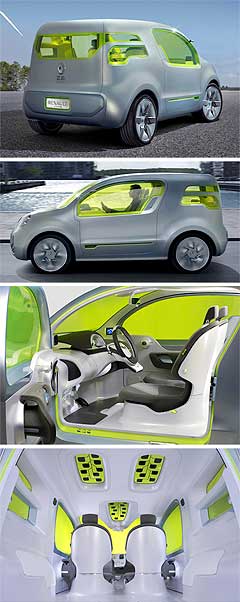Future models - Renault - Z.E. - conceptFirst look: Renault ZE strikes an electric chordStrong brew: Renault likens the Kangoo-based ZE concept to a Thermos flask. Renault shows electric concept in Paris as its 2011 EV deadline draws closer3 Oct 2008 By TERRY MARTIN DETERMINED to flex some environmental muscle and a vision of the future at its home show in Paris last week, Renault took the covers off a ZE (Zero Emission) concept based on the Kangoo light commercial vehicle. While the brand’s Australian arm is still sticking to older versions of the conventional Kangoo light van here, having determined not to introduce the all-new model now available overseas, the French manufacturer has used the new model to demonstrate its commitment a more efficient world and the mass production of electric vehicles from 2011. The ZE is a full-electric EV, using lithium-ion batteries and a 70kW electric motor that delivers 70kW of power and 226Nm of torque.  There are few other technical details available, with Renault preferring instead to highlight some of the big ideas contained in the ZE’s construction and design. There are few other technical details available, with Renault preferring instead to highlight some of the big ideas contained in the ZE’s construction and design.Describing it as a kind of Thermos flask, Renault said the ZE’s bodywork comprises two insulating panels with a sandwich of air that limits temperature variations between the outside ambient temperature and the cabin. It also uses heat-reflective paint to reduce temperature fluctuations that prompt the use of either the air-conditioning or the heater. Functionality of the heating and climate control units has also been overhauled, with Renault rethinking the normal “zones” and creating an environment where hot or cold air can be channelled to areas such as the hands (via the steering wheel) and face to give an impression of warmth or coolness as required. The aim is to make the driver feel comfortable, and disinclined to use the air-con or heater, even when the cabin temperature might indicate otherwise. Elsewhere in the ZE cabin there is other new-age equipment, such as an interactive mobile phone-based navigation system, and interior sensor lights that can detect approaching occupants. Other than the paintwork, interesting external features include the use of solar-powered, streamlined low-energy cameras in lieu of wing mirrors, low-drag full-disc alloy wheels, LED headlights, a range indicator on the outside of the door, and polyurethane gel bumpers. The latter deform to absorb minor knocks with other cars, objects or pedestrians. All motor show Alfa Romeo Alfa Romeo Abarth Abarth Audi Audi Aston Martin Aston Martin BMW BMW Bentley Bentley Chrysler Chrysler Chevrolet Chevrolet Dodge Dodge Citroen Citroen Ferrari Ferrari DS DS Ford Ford Fiat Fiat FPV FPV Foton Foton Haval Haval Great Wall Great Wall Honda Honda Holden Holden Hyundai Hyundai HSV HSV Isuzu Isuzu Infiniti Infiniti Jeep Jeep Jaguar Jaguar Lamborghini Lamborghini Kia Kia Lexus Lexus Land Rover Land Rover Mazda Mazda Maserati Maserati Mercedes-Benz Mercedes-Benz McLaren McLaren Mini Mini Nissan Nissan Mitsubishi Mitsubishi Peugeot Peugeot Opel Opel Proton Proton Porsche Porsche Renault Renault Ram Ram Saab Saab Rolls-Royce Rolls-Royce Smart Smart Skoda Skoda Subaru Subaru SsangYong SsangYong Tesla Tesla Suzuki Suzuki Toyota Toyota Volvo VolvoMotor industry news |
Click to shareAll motor show Alfa Romeo Alfa Romeo Abarth Abarth Audi Audi Aston Martin Aston Martin BMW BMW Bentley Bentley Chrysler Chrysler Chevrolet Chevrolet Dodge Dodge Citroen Citroen Ferrari Ferrari DS DS Ford Ford Fiat Fiat FPV FPV Foton Foton Haval Haval Great Wall Great Wall Honda Honda Holden Holden Hyundai Hyundai HSV HSV Isuzu Isuzu Infiniti Infiniti Jeep Jeep Jaguar Jaguar Lamborghini Lamborghini Kia Kia Lexus Lexus Land Rover Land Rover Mazda Mazda Maserati Maserati Mercedes-Benz Mercedes-Benz McLaren McLaren Mini Mini Nissan Nissan Mitsubishi Mitsubishi Peugeot Peugeot Opel Opel Proton Proton Porsche Porsche Renault Renault Ram Ram Saab Saab Rolls-Royce Rolls-Royce Smart Smart Skoda Skoda Subaru Subaru SsangYong SsangYong Tesla Tesla Suzuki Suzuki Toyota Toyota Volvo VolvoMotor industry news |














Facebook Twitter Instagram